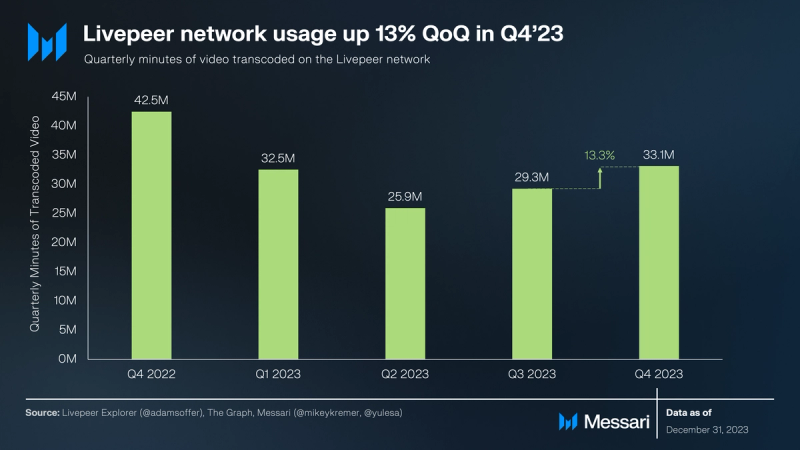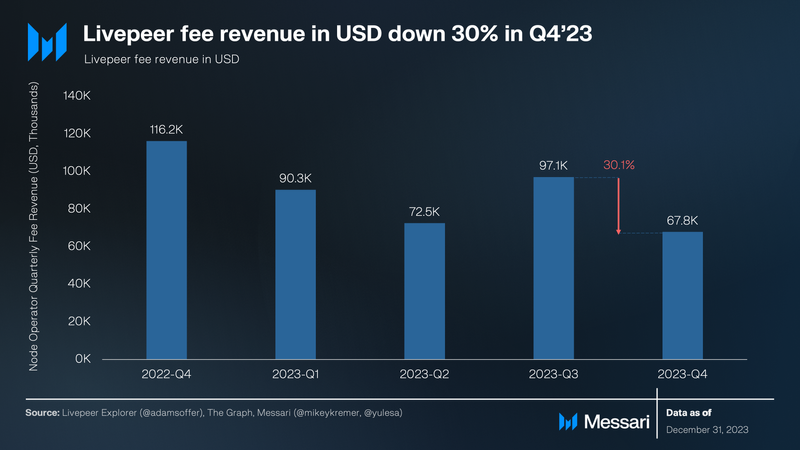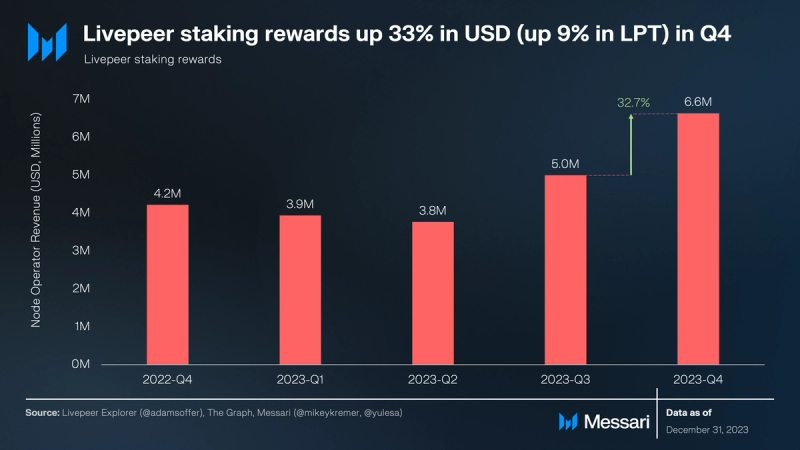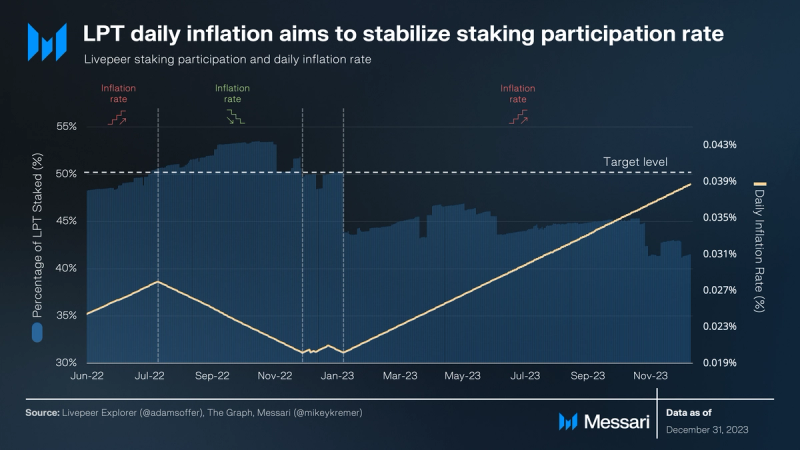Key Insights
- The usage of Livepeer transcoding network grew 13% QoQ in Q4’23, driven by a series of live-streaming video events powered by Livepeer.
- Livepeer demand-side revenue decreased 30% QoQ in USD terms, down 38% QoQ in ETH terms.
- Revenue from staking rewards grew 33% QoQ in USD terms (up 9% QoQ in LPT terms), as LPT issuance reached its highest level since the Arbitrum migration in Q1’22.
- The Livepeer community approved a governance proposal — called Livepeer Delta — to introduce a community-governed onchain treasury for public goods funding.
- Livepeer introduced an AI-powered upgrade to Livepeer docs and developer tools, as well as a revised technical roadmap.
Primer
Building decentralized video apps like Twitch or TikTok requires heavy infrastructure for video streaming. Based on a user’s bandwidth and device, video content needs to be processed — i.e., transcoded — into viewable formats. While cloud providers like AWS, Google, or Microsoft are commonplace solutions for video transcoding services, they incur high costs.
Livepeer offers an open and permissionless transcoding marketplace — allowing anyone to contribute compute resources and to compete on price. The network is designed to reduce transcoding costs for end users by up to 10x.
Within Livepeer’s decentralized transcoding network, there are three key participants:
- Node operators — called “Orchestrators” — route transcoding jobs. The amount of work a node operator can perform is proportional to how many Livepeer native tokens (LPT) it stakes. Node operators earn ETH fees and newly minted LPT rewards.
- Transcoders provide compute resources for node operators and deliver transcoded video content. In return, they earn ETH fees.
- Delegators stake LPT towards effective node operators to help secure the Livepeer network. Staking is rewarded with a portion of both ETH fees and newly minted LPT rewards.
Beyond transcoding, Livepeer aims to build the world’s open video infrastructure and become the go-to decentralized tech stack for developers integrating video streaming into their apps.
Key Metrics
Performance Analysis
Demand for Livepeer services comes from apps and developers in need of video transcoding and live-streaming. For example, decentralized social media (DeSoc) apps, traditional Web2 apps (like TikTok or Twitch), or music streaming apps (like Spotify or SoundCloud) require streaming infrastructure to broadcast content.
Network Usage
Livepeer’s network usage can be gauged by estimating the number of minutes of video transcoded. In September 2023, Livepeer announced a change in the methodology for estimating its usage. This change in methodology aims to address the current challenges in estimating the number of transcoded minutes on the Livepeer network, given that this metric is not directly observable onchain.
While the previous methodology relied on transcoding fees earned by node operators as a proxy for usage, the updated methodology accounts for changes in usage patterns, such as the introduction of video on demand (VOD) transcoding and varying price points. As the usage metric is acknowledged as imperfect but still valuable, the previous data is retained until September 2023, when the change was implemented.

The usage of the Livepeer transcoding network increased 13% QoQ in Q4 2023, as Livepeer poweered a series of StreamETH’s streaming video events in Q4’23, including Base House and Devconnect Istanbul.
Network Revenue
Livepeer’s network revenue consists of demand-side and supply-side revenue.
Demand-side revenue comprises ETH fees accrued from transcoding services. Node operators with larger amounts of stake are more likely to receive more transcoding work, which, in turn, results in them earning more transcoding fees.
Supply-side revenue consists of revenue from:
- LPT staking rewards (accrued by node operators and delegators), which yields inflationary issuance of the token.
- ETH fees for transcoding services (accrued by node operators and transcoders).
The latter doesn’t include ETH fees distributed to delegators, since delegators don’t actively participate in the supply of transcoding services.
Demand-Side Revenue from Transcoding
Fees from transcoding services are paid to node operators in ETH and are further distributed to transcoders and delegators.

Livepeer’s demand-side revenue from transcoding fees decreased 38% in ETH terms, which is equivalent to a 30% QoQ drop in USD terms. This decrease in transcoding fees is a potential consequence of competitive pricing considerations, as node operators are actively discussing how to optimize the price per pixel for video transcoding. The motivation is to support node operators in determining a competitive transcoding pricing to sustainably attracting more transcoding work on the Livepeer network. For context, Livepeer’s Q4’23 demand-side revenue from transcoding fees made up a small fraction of the staking reward revenue (as presented in the next section).
Staking Reward Revenue
The Livepeer network distributes staking rewards in LPT to node operators and delegators. To provide transcoding services on the Livepeer network, node operators must stake LPT. A node operator’s stake weight comprises their own tokens and those delegated towards them.

Revenue from staking rewards grew 33% QoQ in USD terms (up 9% in LPT terms). This increase corresponded with a steady increase in the issuance of LPT rewards, corroborated by the staking participation rate remaining below the 50% equilibrium threshold. The high level of staking rewards indicates that Livepeer network participants are highly reliant on staking rewards for sustaining their day-to-day operations.
Notably, Livepeer shared a postmortem on a critical severity bug reported by a whitehat hacker on October 31, 2023. While the vulnerability caused several addresses to inadvertently earn small amounts of extra LPT rewards, no user funds were at risk. The bug was promptly fixed on November 1, 2023.
Staking Participation
The LPT token follows the Stake-for-Access (SFA) model, also known as a work token model. That is, Livepeer requires its node operators to stake the native token (LPT) to perform work on the network.

The year of 2023 saw the Livepeer staking participation rate — the percentage of the circulating LPT supply that is staked — stay below the 50% equilibrium threshold. This drop in staking participation led to a gradual increase in daily LPT issuance from 0.020% in January to above 0.039% in December. The dynamic LPT issuance in absolute terms follows the staking participation rate as below:
- When the participation rate falls below 50% in a given round, LPT issuance increases by 0.00005%.
- Conversely, when the participation rate passes 50%, inflationary issuance decreases by 0.00005%.
In particular, Q4 2023 saw the lowest participation rate (41%) since Livepeer’s migration to Arbitrum in Q1 2022. It remains how gradually the staking participation is set to return to the 50% equilibrium level over the next quarters. Simultaneously, a series of forum conversations (here and here) revolved aroundn the opportunity to move the equilibrium level to account for the changing supply dynamics of the Livepeer network.
Qualitative Analysis
Key Developments
Interactive Docs Upgrades
Livepeer introduced an AI-powered upgrade to Livepeer docs and developer tools, featuring:
- New development tooling, e.g., an AI-powered chatbot, an Interactive API, multi-language SDKs, and a new command line interface (CLI).
- New features within Livepeer Studio’s hosted gateway to the Livepeer network, e.g., optimizing streaming latency, new clipping capabilities, livestream thumbnailing, multistreaming, user engagement, in-browser broadcasting, transcoding API, as well as monitoring stream health.
The complete changelog is available here.
Potential Technical Roadmap
Several potential key technical opportunities for Livepeer were identified in a blog post:
- Accelerating innovation by enabling video developers to build their own workflows. A technical working group called the Livepeer Catalyst Hackers Group was set up in this sense. Livepeer also aims to address challenges of content authenticity and provenance via its blockchain-based Verifiable Video initiative.
- Bringing AI video compute jobs to Livepeer’s network of GPUs, as detailed by Livepeer co-founder, Doug Petkanics.
- Adding media processing capabilities to the network, enabling more revenue opportunities for node operators and more products built on top of the network.
- Strengthening the network’s resilience through decentralization by reducing dependence and single points of failure on any small groups or entities.
Go Livepeer Releases
Go Livepeer is a Go implementation of the Livepeer protocol which powers the public transcoding network. V0.7.1 and V0.7.0 were released in October 2023 to enhance the quality of the transcoding for node operators and to implement a new selection algorithm for broadcasters. The list of changes can be found in the V0.7.1 and the V0.7.0 release notes.
Community
Node Operator Survey
A node operator survey analyzed the setups and costs of node operators on the Livepeer network. The survey found that:
- The costs of node operators are largely driven by hardware and operating costs.
- Approximately ~80% of the GPUs used for transcoding on the Livepeer network are smaller (predominantly 1070 or 1080) and 20% larger (predominantly 2080ti, 1080ti, and 3090).
- There is an average of four GPUs per node operator. The common GPU setups of node operators are either:
- only smaller GPUs (often similar type, e.g. only 1070) or
- one to three small GPUs and one to two medium/large GPUs per node operator.
The results of the survey should provide insight into the costs and subsequently the profitability of node operators, who are currently heavily reliant on LPT rewards.
Governance
Delta Upgrade and Onchain Treasury
Livepeer Delta and its community-governed treasury were launched in October 2023. The Livepeer community approved a governance proposal to introduce a community-governed onchain treasury for public goods funding for the ecosystem. The first proposals have been voted on, with one passing and one failing.
The Delta upgrade describes a mechanism for populating the Livepeer treasury via a parameterized percentage of the per-round mintable tokens generated by the Livepeer protocol. As of December 31, 2023, over 95,000 LPT were held in the onchain treasury.
The treasury is meant to fund Special Purpose Entities (SPEs) running a focused program like the Grants program or Livepeer Innovators DAO. For context, before Delta, the Grants Program was the main vehicle for rewarding and incentivizing builders in the ecosystem. In the first three quarters of 2023 alone, it handed out more than a quarter of a million dollars to 32 pioneering projects. Simultaneously, Livepeer Innovators DAO (LID) aims to reward retroactive grants to ecosystem contributors to video applications and tools that drive demand for Livepeer. The community has proposed a timeline and eligibility conditions for a round of retroactive grant funding.
AI-Based Video Compute
The Livepeer community discussed the path to bring AI-based video compute onto the Livepeer network beyond video transcoding. A pre-proposal is currently under community deliberation. It aims to provide practical means for node operators to run AI inference jobs on a mainnet sub-network. The discussion comes in the larger context of using decentralized physical infrastructure networks (DePIN) for AI compute.
Closing Summary
The usage of Livepeer transcoding network grew 13% QoQ in Q4’23, driven by a series of live-streaming video events and applications powered by Livepeer. However, demand-side revenue decreased 30% QoQ in USD terms, down 38% QoQ in ETH terms. Revenue from staking rewards grew by 33% QoQ in USD terms (up 9% QoQ in LPT terms), as LPT issuance reached its highest level since the Arbitrum migration in Q1’22.
The Livepeer community approved a governance proposal (Livepeer Delta) to introduce a community-governed onchain treasury for public goods funding. Moreover, Livepeer introduced an AI-powered upgrade to Livepeer docs and developer tools, as well as a revised technical roadmap. Beyond transcoding, Livepeer aims to become the go-to decentralized technology stack for developers integrating video streaming into their apps.
















